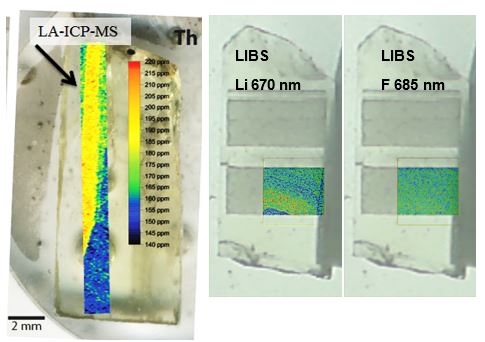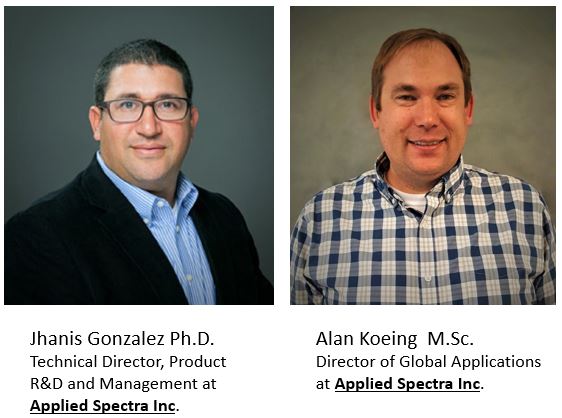Featured Short Course at Goldschmidt 2020: New Trends in Laser Ablation-Based Techniques for Direct Solid Sample Chemical Analysis
The workshop covers new trends on Laser Ablation-Based techniques used for the direct analysis of solid samples. The focused techniques are: Laser Induced Breakdown Spectroscopy (LIBS), Laser Ablation Inductively Coupled Plasma Optical Emission Spectroscopy (LA-ICP-OES) and Laser Ablation Inductively Coupled Plasma Mass Spectrometry (LA-ICP-MS) and the combination of them to use in tandem.
Short Course Format:
The workshop is in virtual format, and split in two days of 3-1/2 hours each day.
Short Course Date and Time:
Day 1: Jun 18, 7:00 AM to 10:30 AM
Pacific Daylight Time (San Francisco, GMT-07:00)
Day 2: Jun 19, 7:00 AM to 10:30 AM
Pacific Daylight Time (San Francisco, GMT-07:00)
Short Course Fee: $120 for both sessions (if register separately, each session cost $80).
Short Course Instructors:
Short Course agenda:
Day 1: Theory and fundamentals -Laser Ablation-based techniques:
o General
o Laser-Induced Breakdown Spectroscopy (LIBS)
o Laser Ablation – Inductively Coupled Plasma -Mass Spectrometry (LA-ICP-MS)
o Laser Ablation – Optical Emission Spectroscopy (LA-ICP-OES)
o Details:
o Laser matter interaction and the resulting plasma and aerosol
o Laser-Induced Plasma – evolution
o Influence of laser ablation conditions of analysis outcome (All techniques)
o Lasers: wavelength, pulse duration, energy, beam profile, and repetition rate
o Spot size, fluence, power density
o Gas environment: Argon, Helium and Air
o Instrumental aspects in general
o Lasers used for ablation
o Hardware for LIBS and ICP-MS
o Chambers for LIBS
o Chambers for Laser Ablation – ICP-MS/-OES
o Influence of the ICPMS operation conditions on ion signal intensities
o Aspects of ablation modes and data acquisition strategy
o Bulk analysis
o Depth profiling
o Mapping
o Classification and discriminations analysis
o Calibration strategies for quantitative analysis
Day 2: Laser Ablation-based techniques in Geosciences:
o Overview
o Impact of Geosciences in the development of Laser Ablation-based techniques
o Impact of Laser Ablation-Based techniques of geosciences
o Applications
o Ablation environment considerations
o Ablation modes relevant to Geosciences
o Qualitative and quantitative analysis of geological samples
o Geochronology
o Mineral analyses
o Chemical mapping
o Isotopic mapping
o Light elements detection
o Software
o Overview of available software packages
o The processing power of ASI Clarity for LIBS and LA-ICP-MS data
o Introducing Clarity Image Plus for advanced elemental and isotopic mapping
o Statistical analysis of elemental distributions (chemical map)

LA-ICP-MS REE elemental imaging over mineral growth zones
Introduction:
The development and modernization of laser ablation is widespread for geology and geochemical applications. A wide array of applications utilizes LA-ICP-MS for geochemical analyses. Spanning both the routine, high throughput applications and the most advanced isotopic and elemental analyses of complex mineral, laser ablation has made significant impacts on the field of geology and geochemistry. More recently, LIBS (Laser-Induced Breakdown Spectroscopy), which is also a laser ablation-based analytical technique, have been gaining popularity for performing rapid elemental mapping in recent times. The advances in the LA sample cell design, LIBS data acquisition speed, instrumentation platform (Tandem LA – LIBS) to enable simultaneous measurement of LIBS and LA-ICP-MS are creating opportunities for extracting a wealth of chemical information and rapidly understanding the distribution of elements and isotopes of interest. LIBS and LA-ICP-MS are becoming go-to techniques for elemental screening and imaging for tissue samples, structured thin films, advanced Li-ion battery materials, and inclusion ID in metals and geological minerals.
In this workshop will outline the basics of laser ablation fundamentals, and the particulars of when used as a standalone technique such as laser induced breakdown spectroscopy (LIBS), or when laser ablation is used as a sampling tool to couple with ICP-MS or ICP-OES, as well as when these laser ablation-based techniques are used in combination to expand their individual capabilities. This workshop will present an in-depth overview of the fundamentals, a review of the most influential parameters affecting ablation, and present modern examples of applications for mineral chemistry, geochronology and chemical mapping. Advances in detection such as using LIBS for analyzing elements such as C, H, O, N and F in combination with LA-ICP-MS allow simultaneous detection of the entire periodic table will be discussed. Positioning the best possible configuration of wavelength, pulse width and LA system configuration allows for optimized performance across the challenging range of sample types brought to the lab by the geologists. The demand for expanded quantification, enhanced spatial resolution and improved reliability and throughput has brought a number of advances to applications in geology and geochemistry.
The already expansive list of LA-ICP-MS applications in geochemistry will be summarized and new areas of research will be presented. The benefits of simultaneous collection of the LIBS spectra during LA-ICP-MS acquisition will also be discussed. This workshop will provide insight into new advances in trace element and isotopic analyses for geology and geochemistry and will be useful to both advanced users and those interested in learning more about laser ablation.

We will also present a snapshot of the software for data processing available in the market with focus on the use of Applied Spectra’s software platforms Clarity and Clarity Image Plus™, a powerful software tool for the J200 LIBS, LA, and Tandem LA – LIBS Instrument, for performing elemental imaging analysis. The Clarity Image Plus software works with optical emission, and mass spectra acquired and processed by the J200 instrument integrated data analysis software Clarity™. Clarity™ seamlessly connects with Clarity Image Plus™ to produce detailed LA-ICP-MS and LIBS chemical maps that can be overlaid on top of the sample image captured by the vision system of the J200 LIBS, LA, and Tandem LA – LIBS instrument. Each pixel on the map captures all emission and mass spectra data and can be displayed in any area of interest. The webinar attendees will get an overview of this powerful software that takes the LIBS and LA-ICP-MS elemental imaging to the next level.
And we will close with our view of the future of these techniques and their role in Geosciences.




